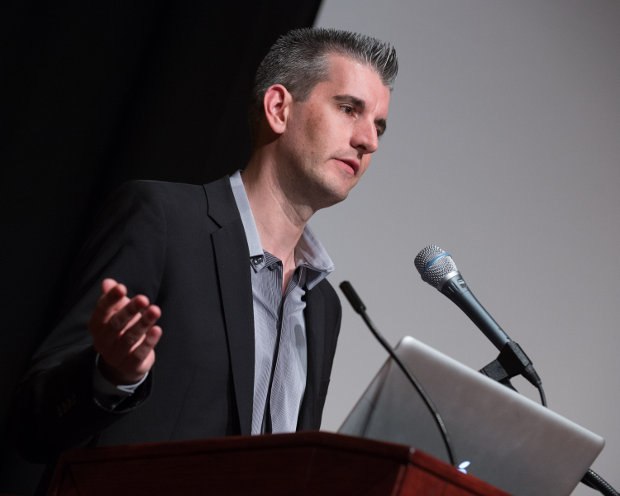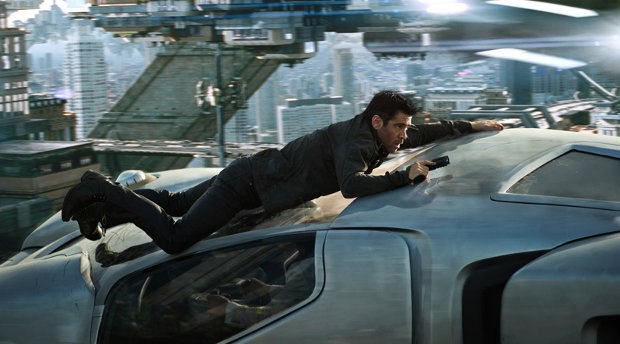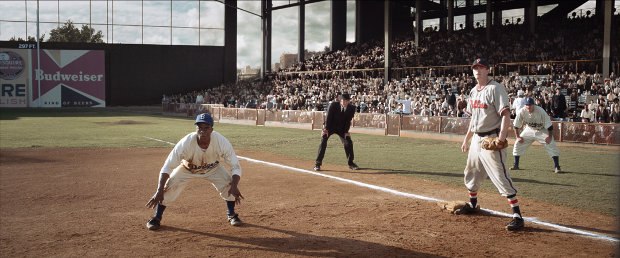A stellar Motion Picture Academy VFX Convergence program shines a welcome spotlight on the world of previsualization.
Watch videos of the panelists answering questions on AWNtv!
Spend any time perusing the conference session lists of events like FMX, SIGGRAPH and VIEW and you’ll find ample selections focused on various aspects of previsualization. And while every day the value and demonstrable production rewards of expanded previs efforts become more apparent, many in the filmmaking community are still in the dark as to how previs is used and, as silly as it might sound, what it really looks like. The reasons for this chasm between practical relevance and general understanding are many. First and foremost, no one can really talk about most previs projects until well after a film is released, which in some cases, is months if not years after the work has been completed. Second, since much of the work is not final, polished, rendered visuals, getting studio approval to publicize often simple looking concept work is not always easy. It’s also hard for many creative professionals schooled in and comfortable with more traditional methods of content development to shift their contextual focus to uniquely collaborative contextual previs methodologies and applications.
But it seems things are changing, and if the April 15th Motion Picture Academy’s VFX Convergence event focusing on previs and postvis is any indicator, maybe the time has finally come where previs artists and their studios can share more of their work with the community at large, paving the way for more understanding and acceptance of the increasingly important work they do. Maybe, previs is finally beginning to get its due.
If you’ve ever spent a day at an industry conference, you know sessions are often a mixed bag. Speakers of various capabilities, some insightful and riveting, some, who after speaking 30 seconds, have sucked all the air out of the room. It’s quite frustrating when your expectations for an informative session are dashed by the presenter’s obvious lack of preparation and ultimate inability to stay on track and actually talk about the topics spelled out in the program. Such laziness if really appalling.
This Academy program, however, was everything a well-organized program should be. It was well planned, with expert presenters who came thoroughly prepared, who spoke intelligently and thoughtfully. They each showed a wide range of illustrative video clips from some of Hollywood’s biggest films. Most importantly, they each presented material whose subjects dovetailed beautifully, with very little overlap. Each presenter covered new ground, but always within the context of everything discussed by the previous speakers. The danger inherent in five speaker panels is that by the third presentation, there’s no new ground and for the rest of the session, you want to gouge your eyes out.
The evening was broken up into two segments – presentations and Q&A. The panelists, fronted by host Michael Tronick, himself an editor and Film Editors Branch governor, were some of the top names in the previs business: Third Floor Inc. CEO and previsualization director Chris Edwards (Iron Man 3, Thor), Halon CEO and previsualization director Daniel Gregoire (John Carter, Cowboys & Aliens), PROOF President and previsualization supervisor Ron Frankel (42, Immortals), visual effects supervisor Sheena Duggal (The Hunger Games, Iron Man 3) and visual effects supervisor Boyd Shermis (Journey 2: The Mysterious Island, G.I. Joe Rise of Cobra).
The presentations began with Michael showing a series of previs sequences from a film he edited, Mr. and Mrs. Smith. He walked through a number of clips from the mini-van chase sequence that included first unit photography with basic animated previs sequences and storyboards cut together. Michael made the point that they were lucky enough to reshoot the scene several times as the final sequence took shape, something not every production can afford and something that previs can help productions avoid. As he described, “It [doing previs] really opened up a world of possibilities to me as an editor. It was very liberating as far as putting scenes together.”
Chris Edwards spoke next, focusing on explaining how previs can impact the visual development of a film from the earliest stages, through onset production and handoff to final post-production.
In its early days, previs was used by vfx supervisors to help visualize and plan more elaborate and complex effects sequences. Previs was seen as more of a technical tool needed to plan complicated shots. That, Chris said, has changed. “Over the years, it’s become an all-inclusive process, a hub of communication, a new medium in which all the various departments and players in the making of a film, commercial, or video game cinematic, can gradually improve the quality of the work they are collaborating on. It’s exciting to see previs come into the forefront and be recognized as that medium of change.”
As he explained, his focus is to support the director, producer and key filmmaking departments in making the film they set out to make. “It [our previs work] really is a continuum of support from its earliest stages where a filmmaker with big dreams wants to create a little pitchvis of their project. Basically, [we help create] a teaser trailer or proof of concept for their project that many production companies and major studios are using as a tool to raise financing and confidence in their project, their director, or both.”
Chris showed a pitchvis clip of the car chase sequence from Total Recall that demonstrated the degree of detail that can be brought to creating a “world” to help sell a movie sequence. In this case, the director wanted to show his unique vision for a particular sequence, something that was not yet part of the script, something he himself wanted to bring to the property, to sell himself to the studio as the director of the movie. The director, Chris said, figured he could add a car chase sequence anywhere in the movie. “Let’s build it and then we’ll figure out where it should go. We need that type of intensity, we need to show off the ‘world.’” To create the sequence, Chris’ team was embedded at the director’s production company, working alongside the art department and production designers. Any spare time the director had he used to review the sequence and give input. The pitchvis showed many of the more exciting visual elements of the magnetic cars and highway, the complexity of the ‘world’ that ultimately were in the final film.
On Oblivion, The Third Floor provided previs on 12 major sequences. In an especially effective and eye-opening clip, Chris, with permission from director Joe Kosinski and the studio, showed the film’s trailer in a split screen, with previs displayed alongside the corresponding final film segments. This technique really demonstrated how concept becomes reality in the production process.
He finished his presentation by adding that previs was an area that might help the vfx industry work through recent economic upheaval by reinforcing Hollywood as content creators by helping producers and directors build a strong blueprint for their movies.
Halon’s Daniel Gregoire spoke next. Another previs veteran, Dan began by saying that people don’t realize previs is not a new thing, that previs has been a part of filmmaking for at least 20 years. He described how almost every major action-set film and many less action-filled films are using previs. In addition to working on big budget productions, Halon often helps young filmmakers previs their films, in the sub $10 million range, sometimes the sub $1 million range, to then pitch to financiers in hopes of getting them produced.
He showed a clip demonstrating a part pitchvis, part previs sequence done by Halon’s Brad Alexander for the film Snow White and the Huntsman. Dan’s teams often handle previs where the director says, “Quick, we need a pitch. We need to sell the studio on this idea because we need money for the visual effects.” They will up-res the work, making it look a little better so the director can walk into a studio or financier’s office and show their vision for a piece of the film. The clip showed the troll fight sequence they produced to help sell the scene. Director Rupert Sanders provided them a troll design on a napkin. In the previs scene, Show White kills the troll. In the final film, she calms the beast and saves the Huntsman’s life. But the tone of the scene remained the same.
Dan also showed Clint Reagan’s work on the med pod sequence from Prometheus. Director Ridley Scott had never used previs before and really enjoyed the process, working directly with the team to find the right tone and mood for the sequence, where to cut, where to combine shots, what to remove because it would be too expensive, what didn’t elicit the response he wanted. The previs actually made people queasy, which was what Ridley wanted. Through previs, Ridley was able to take two lines from the script and turn it into an important, dramatic scene.
He went on to say, “Mostly, previs is used to help people trying to get their ideas out there. They have a foundation, they’re inspired, but need to more fully develop the vision. Previs provides a safe sandbox in which to play, a safe place to fail as often as you want before you capture the good stuff, so you spend your money on the things you really want to do.”
Dan concluded his presentation with the point that because editors, designers and vfx supervisors often aren’t brought in early, previs artists don’t get as much collaboration when it comes to designing key parts of the film. He encouraged producers to bring these key people on much earlier in the production so they can have input in important decision making as it so tremendously impacts the rest of the collaboration and filmmaking process. As he noted, late in a film, “It’s tough to have to be asked, ‘Who did this and why?’
He also emphasized that previs is not just a technical exercise in putting together an animated storyboard. Previs involves artistic visual development. “Both Brad and Clint put on mocap suits and acted out sequences, shot on virtual cameras. They used a hybrid approach, like on Avatar, acting in a suit as well as making decisions on blocking and staging, then editing. It’s a fast, fluid process, to get an idea how humans move and how their weight and staging will interact with the rest of the scene.”
Ron Frankel then took the podium. He showed a broad range of clips, including work from the just released 42, where his company PROOF did almost 30 minutes of previs animation for 25 sequences, mostly hero moments on the baseball diamond. Previs was used in a number of strategic instances in a number of areas across the film. The filmmakers had to solve many important issues before they started shooting on location. Primarily, they needed to figure out how to create a large number of historical baseball stadiums while shooting on only one actual diamond located in Tennessee. In other words, how to purpose and repurpose a very limited practical set build. They needed accuracy in the stadium visuals because audiences would care about the details. They needed to know where to setup blue screens and green screens to enable all the set extensions they’d be creating. Much of this work was done at the urging of the vfx house, which was concerned with the vfx budget and how the shots would be created. For example, how much crowd and set extensions would they have to do? The previs was designed to help develop filming strategies, thus minimizing the amount of vfx needed and keeping as much in camera as possible.
As Ron described, the previs team would create 3D models, which were passed over to the art department. They would then turn them into practical sets. Those would get put back into the previs to test how well they were working. This iterative process really demonstrated the value of great back and forth collaboration throughout the production.
He commented, “There are certain essential creative steps that I see in the filmmaking process. Although it doesn’t happen often, as we discovered, starting with a script is always a really great idea. Having something written on a page is a really good jumping off point. Whether it’s the director, the visual effects supervisor, whoever is going to take charge of the visuals, they should work through some sort of storyboarding process, even if it’s just thumbnails or diagrams, something that begins to describe the structure of the scene. That’s a tremendously important step in the process. It’s really critical. Previs does some amazing things. It’s creative development.”
Ron also emphasized that while they often work on pitchvis projects where the director comes to them with some fantastic idea and asks them to “just run with it,” they often work on things far more mundane but equally as important, that really help push forward the creative process of filmmaking. His teams strive to create something that captures the mood, the tone, the pacing and the emotional content of the final film. They’re also looking to achieve a great degree of accuracy. In all their work, they try to pay close attention to scale, distances, lenses, trying to keep the work as “real” as possible. “If you’re not showing the filmmaker something they can achieve, then there’s no reason to show them anything. It’s just going to lead to frustration and animosity within the production. The director, the producers, the studio will fall in love with it and suddenly it will fall onto the shoulders of the DP and the crew. They’ll look at it and say, ‘There’s no way to shoot this. It’s just not possible.’”
He showed an interesting previs clip from The Amazing Spider-Man, of the iconic scene where Spider-Man, from a first person POV, scrambles from rooftop to rooftop, flying through the air, finally landing smack onto the side of a big skyscraper, revealing his costume in the mirrored window for the first time. Because the first person POV was difficult to watch in stereoscopic 3-D, previs was used to figure out how much of and what type of movement the audience could stomach.
His next clip showed how previs was used on a yet to be announced film to diagram a complex camera move for a scene. It involved multiple camera rigs, planned views to show where the camera rigs would be situated on the set, what parts of the practical set would have to be removed, what parts would be CG, specing out the rigs, the directions the cameras were pointed in, getting down to the nitty gritty of production. Most importantly, it was all done weeks before the set was ever built. As Ron described, all that work was possible because of successful collaborative dialogue between the art department, the vfx team, the camera department and the previs artists, discussing what could be done, what couldn’t be done and how much time was needed to get it done. They were even able to build a custom camera rig because they got the information they needed early enough in the production. The previs work helped so much, during the shoot, they had saved enough time that they were able to take an additional half dozen lighting passes they never thought they’d have time to do.
Ron concluded by discussing how postvis has taken off over the years. Same teams, same tools, but very different from previs. According to Ron, “You’re providing the director and the editor something to work with while they’re cutting the film together. More often than not, what they’re trying to cut simply isn’t there yet. The output becomes a fantastic template for the visual effects houses to use.” On Hunger Games, Ron’s team received a lot of assets from vfx houses, working with the actual rigs, which helped insure they were working with the proper scale and design.
As he showed postvis clips of the mutt chase and tracker jackers scenes, he described how the postvis enabled them to find out what the animals were capable of doing, how they would scale. For tracker jackers, a key issue was how small they should be. Initially, they started out as big as scorpions. As the scene was being built, as the dramatic tension was building, they would change the animation to fit each new version of the sequence, blocking out how the wasps came out of the nest, how they moved, to flow with the tension rising in the scene, the sense of chaos. The vfx artists could then focus on making them all look fantastic, rather than on the iterative visualization process of the design that they’re not always setup to handle.
Ron’s team also created multiple versions with various degrees of gore to help the filmmakers find the ratings sweet spot they were looking for. “Previs artists work fast, iterative, doing multiple passes with different options, trying to make things look as clean as possible, but not worried about the final versions of anything.”
Sheena Duggal spoke next, sharing her perspective as a vfx supervisor who takes previs and turns it into a finished film. She began by commenting, “When you create a pitchvis to sell a movie project to a studio, you’re not really concerned with, ‘How do we shoot that?’ As a visual effects supervisor, it’s my job to take the previs and figure out how we shoot it, how we collaborate with all the other people who are part of the filmmaking process.” For the chariot stadium entrance in The Hunger Games, one of her big challenges was to take previs done by Halon, built with the director’s vision to pitch the movie, done without the boundaries of the physical world, and make that work within a real physical set location.
She showed a fascinating set of clips starting with the original previs sequence, followed by Google Maps-looking images that she called “Techvis,” various shots of the set location, marked up to show placements of chariots, horses, actors and green screens. She also showed final shots from the film, juxtaposed with the original pitchvis, to explain where scale, blocking, distance, crowd placement, camera angles and chariot positioning were modified, sometimes slightly, during the actual shoot.
As she explained, techvis involves getting answers to all the questions regarding shooting the sequence, figuring out all the parameters they had to look at before they could actually shoot the scene. For the chariot stadium entrance scene, issues to consider included:
- How many horses do you need? There are only a certain number of hours a horse can run on asphalt per day. How many yards do they need to run?
- In previs, you’re not thinking about how fast the chariot is traveling. What is a safe speed for the horses and actors? Horses get spooked by reflections and noise. How close can you put a camera to a horse without spooking it?
- What size green screen do we need? How do we design a set, using the physical location we’ve chosen, to maximize the shots based on where and how large our green screens can be setup?
- How can we shoot during the day to get consistent lighting?
- How many rows of the crowd can we get with 400 extras? We only had 400 extras that could effectively be made up as each took an hour to get into costume. How do we shoot the sequence to show 12 chariots when because of budget we only have six chariots?
Visual effects supervisor Boyd Shermis, the final presenter, has been using previs for almost 20 years in one form or another. His portion of the presentation focused on the use of previs in filming native stereoscopic 3-D. He showed a clip from a yet unreleased movie, where he had to design an aerial shot above a cityscape where a helicopter swooped down to handoff the camera to a vehicle on the ground. They mapped out the city of Vancouver, figured out the exact path of the helicopter, figured out the optimal lenses, both in the air and on the ground, figured out where to handoff the air-based camera to the ground-based camera to finish the shot. The previs and integrated planning had to determine how fast the helicopter was traveling, how high off the ground, in what direction and where the ground-based camera had to be met to take the handoff.
On Journey 2: The Mysterious Island, Boyd described how they needed extensive previs since they had creatures, lots of action, practical effects, stunt work, lots of things going on, all shot in native stereo. They had to pay attention to types of lenses, focal length, placement of the lenses and movements of the cameras. He explained, for example, how he learned that you can’t do the same fast action cuts in 3-D because the audience can’t process the 3-D in fewer than 18 frames. “You have to slow things down in stereo,” he said. “You have to let shots breathe.”
Boyd finished up by saying he hoped that soon, we’d see productions where assets were created early on by production design, taken into the previs environment and used all the way into postvis, and that the assets will be accurate enough to hand off to visual effects.
Heads stuffed with dizzying reams of “viz,” the audience took a short break. Normally, on a work night, an evening program loses a large part of its audience after such a pause. However, in a testament to the program’s overall excellence, the majority of the attendees faithfully filed back in for what ended up being an extremely informative Q&A.
Highlights from the Q&A included:
The room filled with laughter when one gentleman asked, very honestly, “I’ve never actually been aware of the work that you do. But I have previously known what a storyboard does. The two seem hardly connected. I’m wondering where the director’s vision stops in the work that is done? As a voting member, how can I realistically evaluate one director’s work versus another except that he has hired the wrong previs company?”
As Chris Edwards explained, previs is not the same as storyboarding. They don’t replace each other. Previs artists collaborate with, not replace, the director. “Storyboarding is an awesome, valuable discipline that will continue for many generations. There are some things that are easy to draw but very hard to do in 3D. But there are certain things that are quite the opposite. Previs is a collaborative part of the puzzle the directors can use at their discretion. We don’t replace the director’s vision. We’re simply trying to keep up with the director’s vision Sometimes they are very specific about what they want. Sometimes, they say, ‘You know what? This is the mood I want to evoke in this sequence. I don’t know specifically how to do it. But while I concentrate on these other aspects of this really complicated movie, you guys go to town, give me a couple different options. I’m going to evaluate them and then steer the ship.’”
Boyd added, “I’ve worked with a number of directors who will come up with an idea and say, ‘I have an idea for a chase through Paris. Go!’ I’ll get all the resources together and hire the company that seems right for the job. I’ll go through it and I’ll design with the storyboard artists.” According to Boyd, some directors are happy just to have something done. They don’t need to watch over it during development.
Ron commented that there are two directions where the previs usually comes from. “One is you have a director with a vision that the previs team and the rest of the production is trying to keep up with. The opposite is you have a director who doesn’t necessarily come with a well-developed visual sense of what they’re looking for, but will know it when they see it. But they have to see it first. It’s just a different creative process.” As he explained, you’ve got the production designer, the vfx supervisor, the previs team, everybody trying to put something together to put in front of the director so they can understand what that director’s vision is, so they can know what to expect when they get onset for the shoot.
“Storyboards work incredibly well as an initial process, to get the visual idea down on paper,” he commented. “Where storyboards start to come up a little thin is when things are in motion. Trying to convey that sense of motion. Car chases don’t really work well in storyboards. Big action sequences with trolls and forests tend to fall apart a little bit when you’re just working with storyboards.” Previs, he concluded, can be crucial in helping fill the gap between the nascent idea and when you show up on set saying, “OK, what do I do?”
And in a fitting finale to the evening, someone in the audience wondered why standalone previs companies ever got started in the first place, stating, “I would have thought that the major visual effects companies would want to have that in their realm.”
Sheena’s take was that the director may feel that the vfx company may suggest doing a scene a certain way based on the price, that they may have ulterior motives in their recommendations.
Boyd added that visual effects houses have established pipelines and particular ways they like to work that don’t necessarily lend themselves to quick or nimble iterative collaborative work. As he explained, previs teams are designed to work really fast, turning stuff around in 30 minutes sometimes. “If it has to go through a big machine, with a production coordinator saying they’ll have to check but they can probably get it done next Thursday, it just can’t work that way. You have to work iteratively with the artists.”
Ron added, “A lot of the work we’re doing is not for visual effects. We might do a lot of work with stunts. We certainly do a lot of work with the art director, the art department, helping them test out their set designs. By keeping the previs independent from all the departments, it isn’t really the domain of any one department. While the defacto clearinghouse for this work is often visual effects, there are a lot of films that we work on that have very little to do with visual effects.”
And finally, Dan added that many of these films use lots of vfx houses. “Scanline is doing the water effects, ILM is throwing in the robots. Keeping continuity between all these different components and pieces of the film, it’s better to have it in one group that understands it from beginning to end how it works.”
The evening ended with a final round of well-earned applause. At least for one night, the industry spotlight shone brightly on the field of previs. Hopefully, such deserving attention becomes more the rule than the exception.
--
Dan Sarto is editor-in-chief and publisher of Animation World Network.
Dan Sarto is Publisher and Editor-in-Chief of Animation World Network.






















